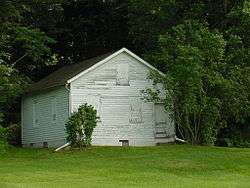Everett Historic District (Peninsula, Ohio)
Everett Historic District is a rural village located within Cuyahoga Valley National Park. It is registered on the National Register of Historic Places.[2] Everett is unique for being uncompromised by the pressures of suburban development. It represents a typical unincorporated hamlet of the turn of the 20th century rural America.
Everett Historic District | |
 | |
  | |
| Nearest city | Peninsula, Ohio |
|---|---|
| Coordinates | 41°12′16″N 81°34′29″W |
| Area | 17 acres (6.9 ha) |
| Architectural style | Late Victorian |
| NRHP reference No. | 93001467[1] |
| Added to NRHP | January 14, 1993 |
The historic district comprises the village buildings, dating from the 1880s to the 1930s, along with their outbuildings (a varied collection of outhouses, garages, chicken coops, barns, and a milk house. Everett formed due to the existence of Johnny Cake Lock on the Ohio and Erie Canal. The settlement was renamed Unionville, and still later Everett[3][4][5] in honor of Sylvester T. Everett, the Valley Railway's vice president and treasurer.[6]
The district overlaps part of the Everett Knoll Complex, an archeological district associated with the prehistoric Hopewell culture. This area was also used by the Civilian Conservation Corp for a nursery that played a key role in the development of the state and metropolitan parks in the area.
References
- "National Register Information System". National Register of Historic Places. National Park Service. March 13, 2009.
- "Everett Historic District". Ohio and Erie Canal National Heritage Corridor: A National Register of Historic Places Travel Itinerary. National Park Service.
- Lane 1892, p. 655.
- Tamburro & Galonska 2002, p. xvi.
- Kovacs, Rosemary (April 19, 1973). "Map and Memories Preserve Old Towns". The Plain Dealer. p. A15.
- Tamburro & Galonska 2002, p. xvix.
Bibliography
- Lane, Samuel A. (1892). Fifty Years and Over of Akron and Summit County. Akron, Ohio: Beacon Job Dept.CS1 maint: ref=harv (link)
- Tamburro, Sam; Galonska, Juliet (2002). "Introduction". Guide Book for the Tourist and Traveler Over the Valley Railway: The Short Line Between Cleveland, Akron, and Canton. Kent, Ohio: Kent State University Press. ISBN 9780873387354.CS1 maint: ref=harv (link)
Further reading
| Wikimedia Commons has media related to Everett Historic District. |
- Brose, David S. "The Everett Knoll: A Late Hopewellian Site in Northeastern Ohio". Ohio Journal of Science 74 (1974): 36–46.

